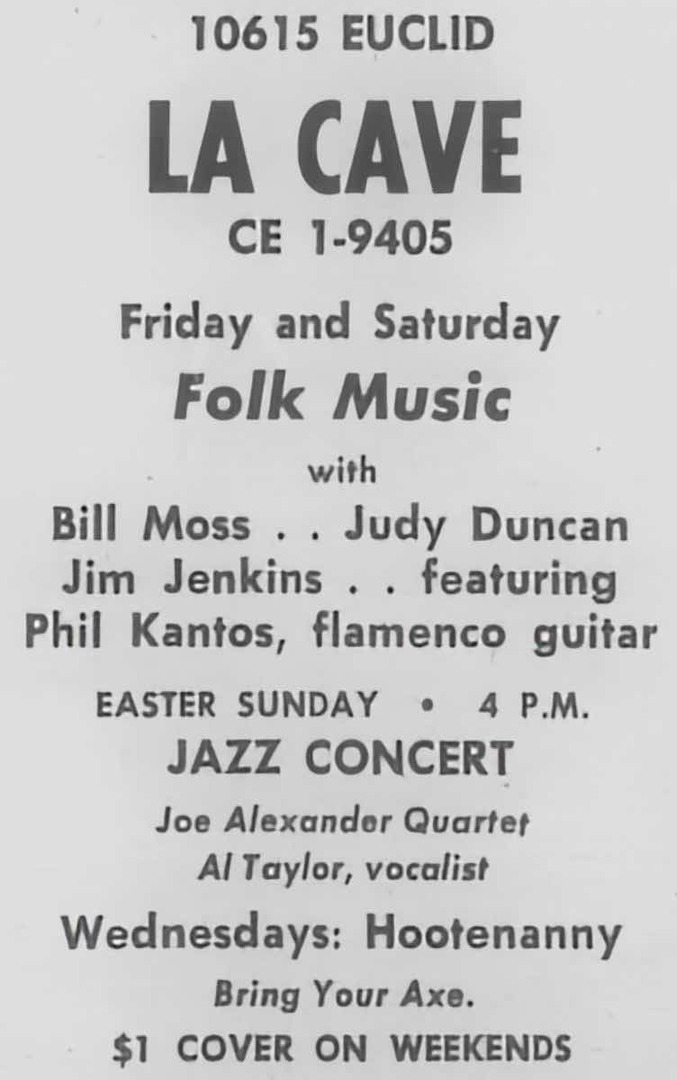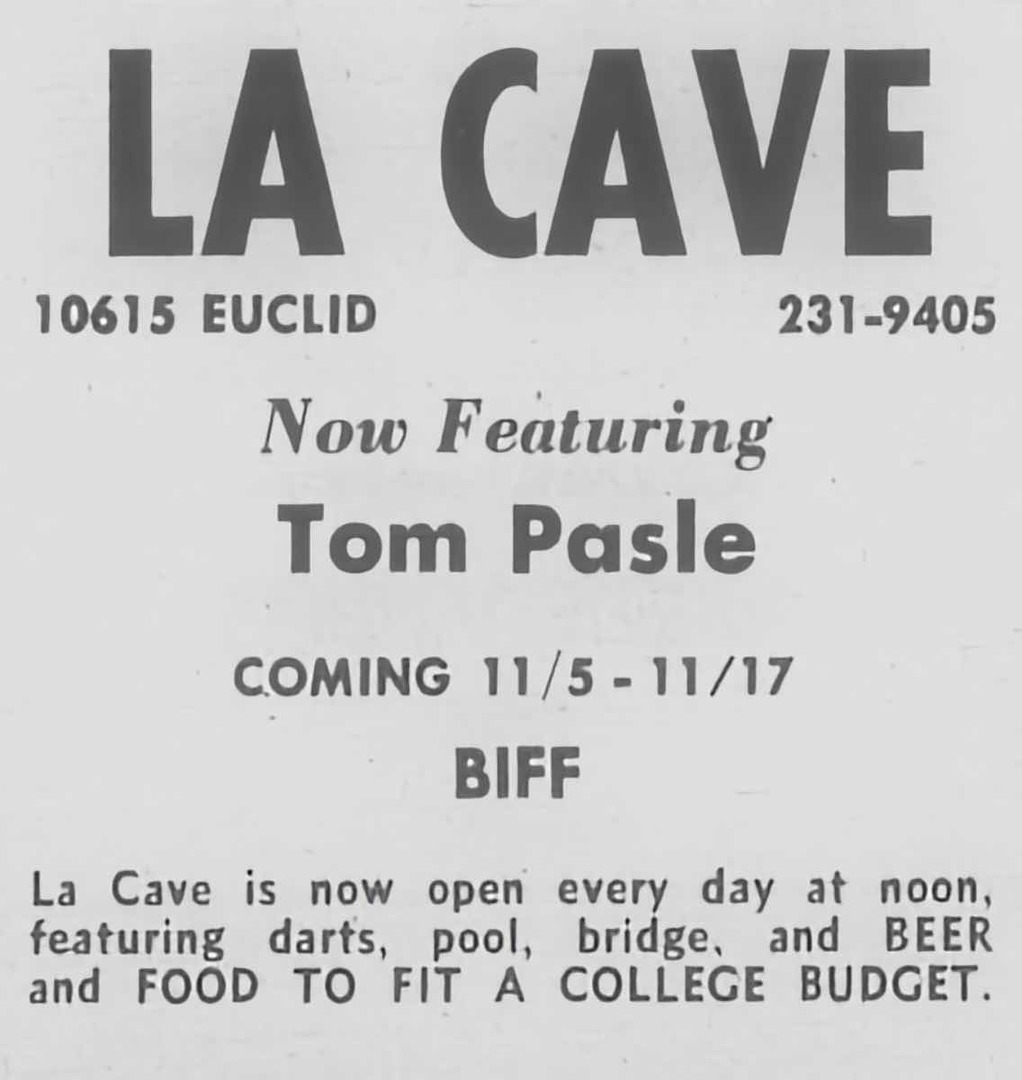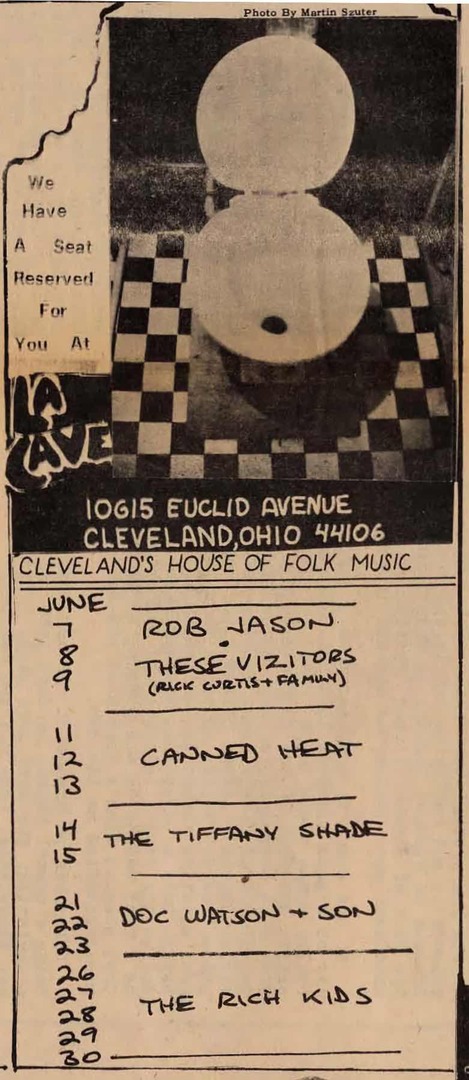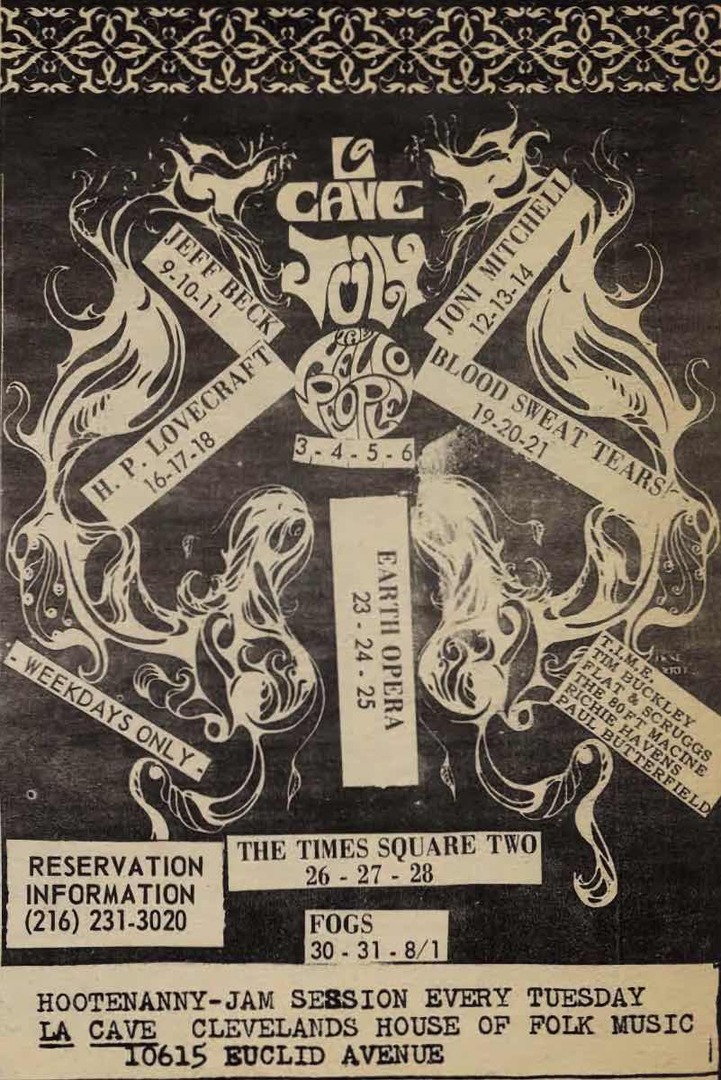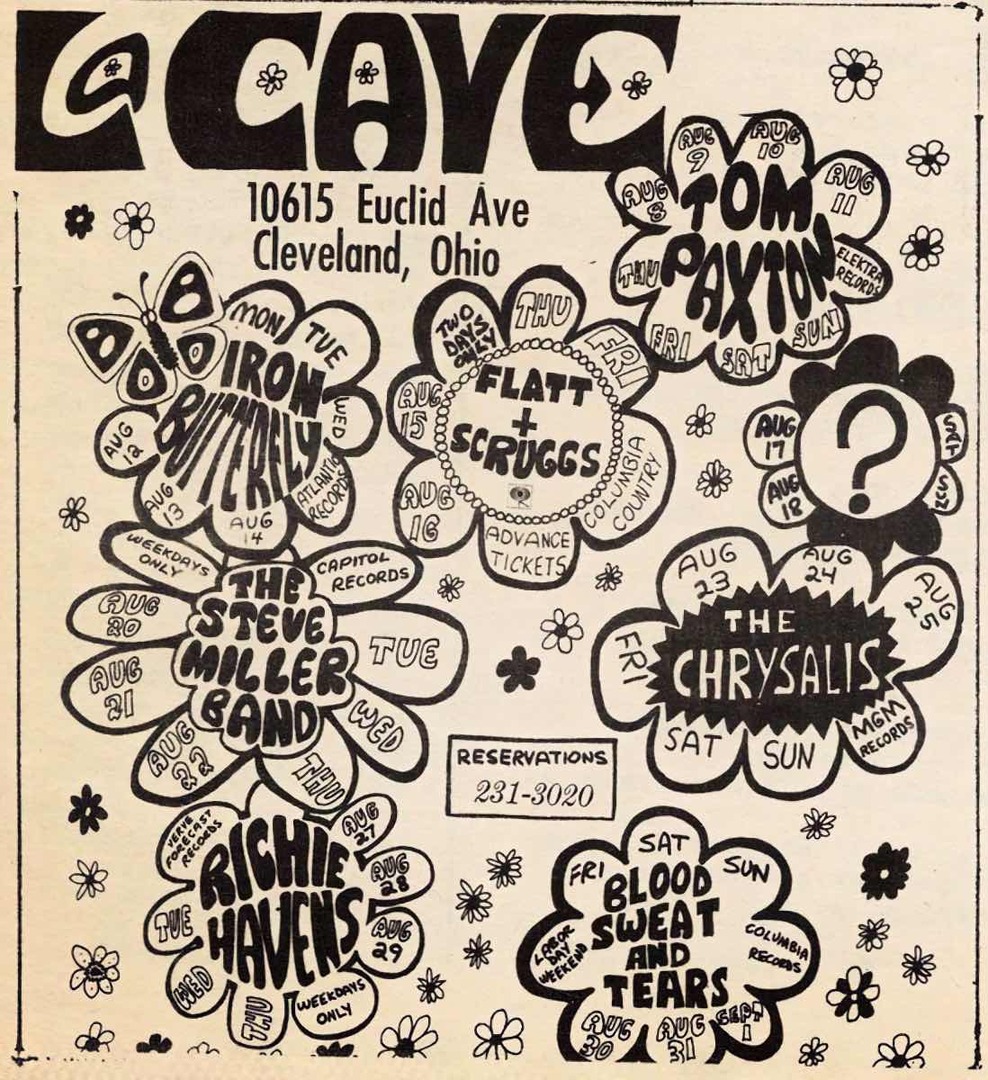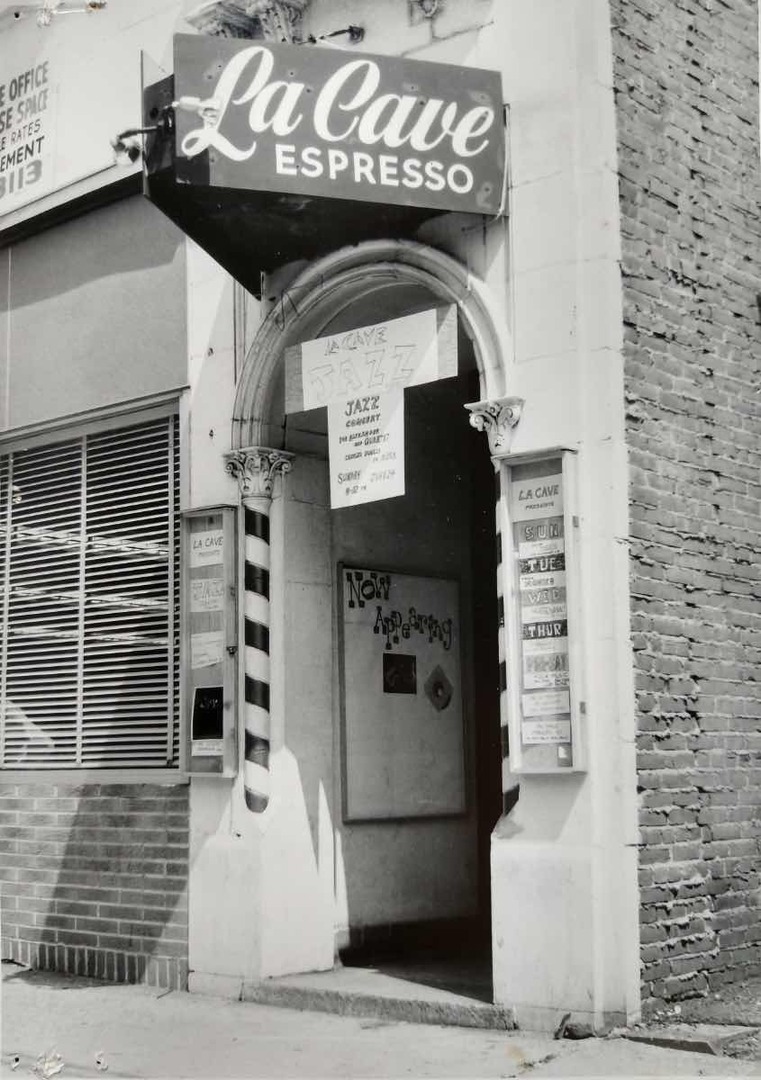
Entering the door marked 10615 from the sidewalk on the north side of Euclid Avenue near East 105th Street in the late 1960s, you would have descended a staircase and entered a large, dim room with tables surrounding a stage. Posters and artwork glowed purple on the walls, thanks to the black lights overhead. As one Western Reserve University student observed, the room’s layout created “an intimacy between audience and performer that [was] impossible in a large auditorium.” The atmosphere of this basement venue reflected a transformation from its early ’60s start that was every bit as dizzying as the metamorphosis of popular music in the same years.
Into the early 1960s, Cleveland nightlife opportunities for students and young adults were limited until the opening of La Cave, a coffeehouse turned folk music club within walking distance of University Circle. La Cave provided an affordable and eclectic local music venue that enhanced the nightlife for younger crowds and helped establish Cleveland’s future reputation in rock music culture.
La Cave opened in 1962 in Cleveland’s “second downtown” area, which was centered at Euclid Avenue and East 105th Street. Taking its place alongside movie theaters, bars, restaurants, and stores, La Cave opened as a coffee and folk music house but was not initially successful, at least not until Stan Kain, an eager businessman and folk music lover, took charge of the business with a plan to bring popular folk artists to the Cleveland area.
Kain brought acts like Phil Ochs, Simon & Garfunkel, Janis Ian, Tim Buckley, and countless more successful folk artists to La Cave in its earlier years. A mixture of the artists who played at La Cave and the accessible location drew in a young clientele from nearby schools such as Western Reserve University, the Case Institute of Technology, and the Cleveland Institute of Art. Overall, the music and atmosphere was something fresh, making La Cave popular for the younger generation.
La Cave truly filled a void. College students' concerns about a lack of on-campus entertainment in the early 1960s were especially pronounced where music was concerned. As the Case Tech newspaper reported, students leaned towards blaming the “lack of adequate facilities.” However, this issue came not from the university but from the performers. The Case Student Congress president noted that “big-name performers would ask exorbitant rates due to the seating capacity problem.” Cleveland lacked small clubs like La Cave that offered affordable tickets, high-value performances, and a unique listening experience. Students were unhappy with the prices of higher profile groups, but also dissatisfield when less well-known groups performed (even with cheaper ticket costs).
Despite the rapid growth of La Cave’s popularity, Stan Kain managed to maintain a business that suited the younger generation. With costs and types of food, drinks, and a consistent yet different atmosphere, La Cave still drew in college students as its main demographic. Examples of these aspects include food such as “nibbles” like sandwiches, pastries, seafood, and pretzels, and drinks like beer, coffee, tea, and soft drinks. La Cave’s advertisements emphasized the affordability of these offerings. A central line for most of its advertisements was, “BEER and FOOD TO FIT A COLLEGE BUDGET.” Advertisements also made sure to include ticket prices (starting at $2.00), new hours, and in-house activities like bridge, darts, and pool.
Kain worked hard to maintain the La Cave experience through the performers he booked to play there and the events he hosted. One of these events was a folk festival featuring Bob Gibson, Josh White, Tom Pasle, and the Knob Lick Upper 10000. By booking bands like the Knob Lick Upper 10000, a pure bluegrass group, the festival allowed listeners to see the typical La Cave performance while also engaging with what was for many patrons an unfamiliar genre. This festival gave Kain an opportunity to explore the idea of venturing beyond just folk music.
Over time these acts built La Cave’s popularity and helped the club change alongside the evolving rock music scene of the mid to late ’60s, potentially jeopardizing their reputation and integrating unconventional music in Cleveland. One of the main acts that brought a new wave of popularity to La Cave was the Velvet Underground, whose shows — especially “La Cave 1968: Problems In Urban Living” — were some of the most influential concerts in La Cave’s history. The Velvet Underground’s shows at La Cave opened doors for other rock performers to test out the crowds in Cleveland. The reputation of La Cave changed from a folk cafe to a rock 'n' roll venue where managers and agents of big acts (such as Jefferson Airplane, Hello People, Jeff Beck Group, etc.) were now contacting Kain to have their performers play while hooking the younger generation on rock 'n' roll sound.
Although a big reason for La Cave’s popularity was its affordability, it was harder to maintain as the years went on. Many artists that regularly played at La Cave began to outgrow the small venue, and it was harder to get replacements or new performers in general. Price rises in tickets and food heavily affected the turnout at shows and diminished its draw for students. As the Cleveland underground newspaper The Buddhist Third Class Junkmail Oracle observed in 1969, “The major source of problems seems to be a conflict between the kind of concerts students want, and what can be afforded.” Ultimately, Kain was unable to overcome the challenges and the financial problems they caused, forcing him to close down in July 1969.
La Cave’s journey from a small bohemian café to one of the most influential rock venues in Cleveland assured its status as one of Cleveland's most impactful music venues. Despite its short run, La Cave enhanced the college experience in University Circle while simultaneously pointing to Cleveland’s future reputation as the nation’s “Rock and Roll Capital.”
Images

